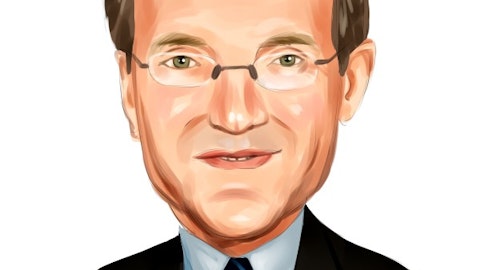Operator: The next question comes from David Scharf with JMP Securities. Please go ahead.
David Scharf: I wanted to shift to the cost side and maybe a question for Pete here. As you noted, there are always a lot of competing dynamics both timing related, such as ramping up the legal channel again and macro related. But notwithstanding sort of the 2023 guidance range for efficiency ratio, kind of wondering, as you think about the progress you’ve made in digital, some of the other productivity enhancements, both domestically and in Europe. How should we think about it? I mean do you think about a peak efficiency ratio in this business? I mean I know we saw just some crazy stimulus early 2021 levels in the 65.6%, and 65.7% range. And that’s probably not the answer. But is 60.61 in your mind a normalized level? Or you — do you have a long-term goal in mind? Do you think about all the different investments you’re making?
Pete Graham: I think you rightfully pointed out kind of pressure that we’re seeing in advance of this cycle. I’ve talked on prior calls about the fact that we’ve got some slack in the system. That we feel like we’ll be able to absorb increased purchases without kind of a one-for-one ramp in variable costs associated with that. So that said, I don’t think the level that we’re forecasting for 2023 in that kind of low 60s range. I don’t feel like that’s in any way the long-term trajectory for this business. I think we’d like to push our efficiency back to levels we saw during the pandemic and beyond as we think about continuing to drive efficiencies in the core operation and think about all other elements of our cost base and trying to continue to improve and drive efficiency in the operation.
David Scharf: Got it. I know it’s helpful. Just trying to gauge kind of what a potential feeling is. Shifting to the purchasing side, I know in years past, you’ve always been quick to caution that any time there is a significant quarterly performance in Europe, regardless of the countries you’re buying from, very often, very lumpy that it might be one or two banks unloading some non-performing loans. Was that the case in this quarter? Or should we read this more broadly is more supply coming down the pike in 2023 out of the more to expand on the countries beside the U.K.
Pete Graham: Yes. I think what Kevin was trying to say in his prepared remarks was it was pretty broadly dispersed across the — all of our geographies in Europe during the quarter. We did have some larger deals in the Nordics, but we also bought in all but one of the markets. And so, it’s a really great quarter in terms of that geographic diversification.
David Scharf: Okay. And maybe just one quick follow-up just to clarify in the U.K., that’s primarily a non-credit card market for you. Is that correct? I mean is it similar like mostly personal installment loans — personal loans like the capitalize the other markets in the continent? Or is it mostly credit?
Pete Graham: No. It’s more geared towards credit card paper quite frankly.
David Scharf: In the U.K.?
Pete Graham: Yes. But as Kevin said, we’re still not seeing — we have some forward flows in that market. We’re still not seeing any real change in fresh charge-off. I’d say the U.K. market maybe is a little behind the U.S. market in that regard, but there has been other types of back book sales and things like that, that have supported the market broadly.
Operator: The next question comes from Mark Hughes with Truist. Please go ahead.
Mark Hughes: I think you said the change in estimates was $15 million, and that was a component of the change in expected recoveries, is that correct? So implying that over performance in the quarter was $19 million. And I forget about that properly?
Pete Graham: Yes. That’s round numbers. That’s right. Over performance and other kind of cash adjustments that happened in the quarter, put backs and things like that.




